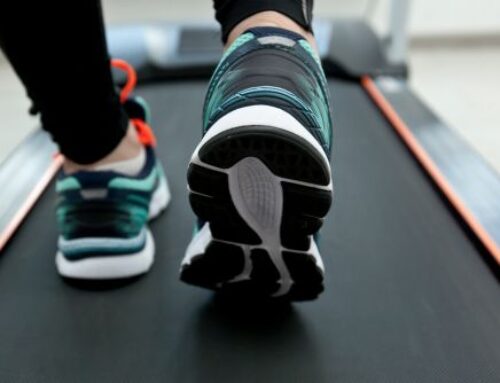While intended to be done about three times a day, you’ll want to wait for at least two hours in between sessions, because that’s how long it takes for nitric oxide to synthesize in your body for subsequent release and optimal benefit. It’s hard to believe, but in those few minutes, you can get the same benefits as if you’d worked out in the gym for an hour.
This short series of exercises could be called a new version of high-intensity interval training. It’s designed to stimulate the release of nitric oxide, which is actually a soluble gas and free radical stored in the lining or endothelium of your blood vessels that can catalyze and promote health.
One reason it’s not wise to indiscriminately take high doses of antioxidants is because you do need some free radicals. Nitric oxide is one that causes your blood vessels to expand and dilate, which can lower your blood pressure. It also improves your immune function, stimulates the thinning of your blood and decreases its viscosity, which in turn decreases platelet aggregation.
When your platelets are sticky, it can cause the development of a blood clot, which could then cause a heart attack or stroke, two very common causes of death. In addition, another benefit of nitric oxide is that it’s a powerful anabolic stimulus that can help you increase lean body mass. One reason this is considered so important is that when you increase muscle mass, you’re able to burn more fat.
Nitric Oxide, a ‘Communication’ Molecule
Nitric oxide is a molecule your body makes that feeds your muscles, so when you run out of oxygen when you begin exercising, your muscles start to ache, Bush explains. When nitric oxide is released to make up for it, it moves through your bloodstream, your blood vessels dilate to deliver more oxygen and nutrients, and that’s how your muscles develop. According to Bush:
“Our blood vessels actually only store about 90 seconds’ worth of nitric oxide before they need to manufacture more, so working each major muscle group out for 90 seconds gives you the most efficient workout to tone and build muscles.
The body has the ability to regenerate nitric oxide every couple of hours, giving you the opportunity to release it multiple times a day. What that means is the most effective way to increase your muscle function is to work out very briefly every few hours.”1
In that four minutes, you work 16 of the largest muscles groups in your body. Bush calls it one of the best ways to start toning your body’s systems, plus it’s free and so easy nearly anyone can do it. Another convenient part of the concept is that you really can complete a quick workout multiple times per day. You can do it whether you’re on vacation, at work or at home, plus it doesn’t matter what you’re wearing, provided you can move freely.
The Nitric Oxide ‘Dump’ — A Very Efficient Workout Strategy
What these short workouts do is increase the opportunity for muscle to build, Bush says, adding, “The cool thing is that you rebuild that nitric oxide every couple of hours.” If it’s released three times a day, you have the added benefit of your muscles deciding when it’s time to grow, feed and breathe. A typical four-minute workout entails three sets of 10 repetitions or “reps,” but you can eventually work toward increasing it to 20.
Hand weights aren’t necessary or even recommended at first, although you can also work toward using them later if you’d like. By focusing on form and speed, you run out of oxygen at your large muscle groups at the joints. It’s a new level of fitness, but form is important and only once you’ve mastered form should your pace increase over time.
Here’s the drill for each of these movements. Again, start with three sets of 10 repetitions. As you feel comfortable, move to 20 repetitions with each exercise. At the end, you’ll have completed 240 movements. Here’s an important stipulation, however: As you’re exercising, don’t breathe through your mouth. Keep your mouth closed and breathe only through your nose.
Squats: Legs — Glutes, Hamstrings, Quads, Calves — and Abs
“A good squat is your butt going back and looking like it’s going to sit in a chair. It’s not just a simple knee bend,” Bush explains. Further, your arms have to be held forward in front of you to maintain balance, especially as your weight shifts backward; first you “sit down,” then you straighten back up again.
To help you do that, your feet should also be placed as far apart as your shoulders, and if it bothers your knees or back, you just make the movements more shallow. You’ll get the same activation in your quadriceps. The goal is to keep that muscle engaged, but your speed is actually more important than the depth of your squat.
- Begin by standing with your feet hip-width apart, feet parallel, toes pointing forward and the weight of your body distributed evenly between your heels and the ball of your foot.
- Perform 10 squats in rapid sequence, keeping your quadriceps engaged.
If you have knee problems that make squats problematic, get into the seated position by placing your back flat against a wall for 30 to 60 seconds or until your thighs begin to ache. Bush’s video, above, shows you how to do it.
Tin Soldier: Shoulders — Deltoids and Triceps
To start, swing your arms at a simple 90-degree angle, which helps work a number of muscles in your deltoids, which are the rounded, triangular-shaped muscles on the uppermost part of your arm and the top of your shoulder (hence, the name “deltoids” after the Greek letter delta, which is shaped like an equilateral triangle2 ).
In fact, the arm swings from your waist, alternately right and left, go in front of you to shoulder height and encompass other muscles in your shoulders and back. Your hands should make loose fists and be pointed downward. In addition, it’s important to keep your form tight and maintain muscle control rather than just flapping your arms up and down, Bush says.
- Alternately, achieve 90-degree elevation in each arm.
- Begin standing straight with your arms at your sides. Lift your right arm in front of you to a 90-degree elevation, then swiftly drop it back down to your side while raising your left arm, also to a 90-degree elevation.
- Alternate left and right, repeating 10 times each side.
Snow Angel: Back — Lats, Traps, Deltoids, Rotator Cuffs
This part of the workout is basically a jumping jack without the jump to work your latissimus dorsi muscles (lats), whose name means “broadest muscle of the back,”3 and trapezius muscles (traps), the large muscle that extends from the back of your head down your neck and into your upper back. Again, make sure you don’t get sloppy, but “click” your fists together both at the bottom and again at the top to get the full range of motion and the full benefit of the workout in your shoulders.
A modification if you have shoulder problems is to simply move in the opposite direction: Start at the center, hands clasped in a prayer position in front of your face, reach up in the center over your head and bring your arms downward on each side. “It’s almost like you’re doing the breast stroke. It’s amazing; even if you have frozen shoulder how that can break things loose and loosen it up,” Bush explains.
- Begin standing straight with your arms down, fists touching in front of your pelvis.
- Use a broad rotation, circle your arms upward on each side to touch your fists over your head.
- Circle back down to hit fists at the bottom and repeat 10 times.
If you have shoulder problems with your rotator cuffs, try this variation instead:
- Start with hands at a prayer position in front of your chest.
- Keep hands pressed together lightly as you extend them above your head.
- Circle your arms out to the sides to release before bringing them back to the prayer position. Repeat 10 times.
Military Press: Shoulders and Arms — Traps, Neck, Deltoids, Triceps
You could call this next exercise the “invisible pullup.”
- Bring fists above your shoulder to either side of your head, elbows bent.
- Extend arms straight above your head.
- Return to position with fists just over your shoulders and repeat 10 times.
Then, without breaking your tempo, return to start the second exercise set in the same sequence: Squats, tin soldiers, snow angels and military presses, until you complete three sets. Bush notes that at the end of the four-minute exercise, it’s important to mentally regroup to allow your body to catch up to the enormous increase in blood flow. What you’re feeling is the liberation of nitric oxide.
“Resting with your hands at your sides, close your eyes and experience the sensation in your extremities. You may feel tingling or sense increased blood flow as all your blood vessels dilate, delivering oxygen and fuel for optimal health.
Relax, shake it out and feel your fingertips. You’ll feel a little tingling and a little puffy over the next 20 seconds. That’s the nitric oxide effect. You’re dilating all those blood vessels, oxygenating everything from your brain to your kidneys and everything else in your body, and you’re building muscle for the next couple of hours.”4
If you repeat that three times a day, you’ll find a change in your metabolism and muscle capacity so you can strengthen and maintain that lean muscle, Bush adds. It essentially changes the number of calories you burn even while you’re sitting still. It’s an exciting shift in our concept of exercise.
As mentioned, the Nitric Oxide Dump, when done correctly, entails starting at 10 reps and working up to 20, paying attention to your form, and completing the sequence two or three times a day, every day. You can do it no matter where you go — I even do it at the airport as I’m waiting for my luggage. You may look a little odd, but remember, it’s an extremely effective workout and totally free, and best of all, it will help you take control of your health.
Source:
- 1, 4 Zach Bush MD 2017
- 2 Inner Body Deltoid Muscle 1999-2017
- 3 Inner Body Lattimus Dorsi Muscle 1999-2017
https://fitness.mercola.com/sites/fitness/archive/2017/11/03/4-minute-daily-workout.aspx





Leave A Comment